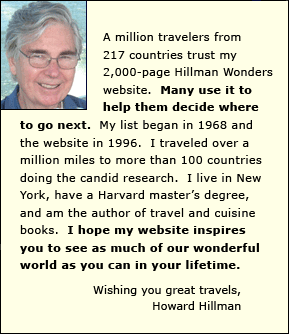



travel photo mistake
#4
Not knowing how
to shoot landscapes
 Click blue links for all top 10 travel photo mistakes
Click blue links for all top 10 travel photo mistakes
![]()


when you shoot landscapes
![]() Best times for
Best times for
landscape photography
Early morning and late afternoon are usually the best times for landscape photography. Low-angle sunlight creates warm colors and contrasting shadows. Midday sun casts hard light.
![]() Visual distractions
Visual distractions
Few amateur travel photographers attempt to eliminate elements from the scene that do not lend supporting interest. Their pictures contain irrelevant objects, such as a mundane railing in the foreground or a nondescript vista on the side of a spectacular mountain peak.
There are proven ways to purge those distractions, including zooming in or scouting out an optimum vantage point.
![]() Dealing with
Dealing with
tourist crowds
Unless their existence is part of your photographic story, keep clusters of tourists out of your landscape photos. Their visual presence can undermine a landscape's desired qualities.
Tourist counts are usually lowest in the periods just after a site opens and just before it closes. Other good times include lunchtime, weekdays and non-peak seasons.
![]() Landscape foreground
Landscape foreground
 A picture benefits from a foreground object such as a person or flowering bush. It helps establish a sense of scale and depth of the main subject (for example, mountains).
A picture benefits from a foreground object such as a person or flowering bush. It helps establish a sense of scale and depth of the main subject (for example, mountains).
 The foreground object should be easily seen, but not be so striking that is competes with the background, your main subject.
The foreground object should be easily seen, but not be so striking that is competes with the background, your main subject.
 An advantage of using a person in the foreground of a landscape picture is it personalizes the scene. It also adds a touch of life to it.
An advantage of using a person in the foreground of a landscape picture is it personalizes the scene. It also adds a touch of life to it.
 If the person you are using appears tiny on the image, it helps if that person is wearing a bright red shirt. Pros know this trick.
If the person you are using appears tiny on the image, it helps if that person is wearing a bright red shirt. Pros know this trick.
![]() Lens terms
Lens terms
 Depth of field
Depth of field
Lenses with a high f-stop number (which means a narrow lens opening) are better for keeping both the foreground and background in sharp focus than are lenses with a low number.
 Wide vs telescopic
Wide vs telescopic
For most landscape photography, a wide-angle lens produces a sharper resolution than would a telescopic one.
![]() Panoramic shots
Panoramic shots
Some cameras (and photo editing software) can merge two photos, creating an extra-wide one.
This is not a gimmick feature. Sooner or later in your travels, you will encounter a landscape with a sweeping grandeur that only a panoramic shot could capture. If your camera or software has that feature, it pays to learn how to use this landscape photography technique.
Also learn to avoid these
top 10 travel photo mistakes
1 - Photographing people
2 - Composing your shots
3 - Using flash
4 - Taking landscape shots
5 - After your trip
6 - Memory
7 - Camera features
8 - Batteries
9 - Lens
10-Other situations

World's Top 100 Wonders
World's Top 1000 Wonders
Site map
My credentials
About my website and criteria
Reader testimonials



